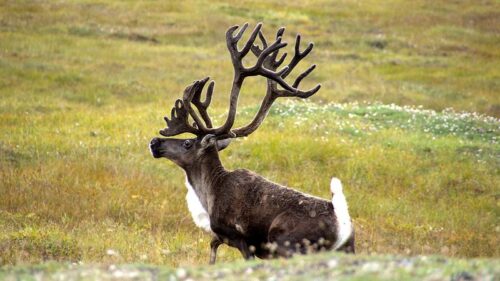
ADFG Releases Mulchatna Caribou Herd Information Page
As Alaska Department of Fish and Game made a controversial decision to use predator control to help sustain a declining Mulchatna Caribou herd last summer, ADFG has released an information link to discuss the rationale behind eliminating bears and wolves last summer to help a herd that has, like many caribou herds in North America, been on a steady decline.

Here’s some of ADFG’s frequently asked Q&A information page when discussing the predator control:
Why kill bears and wolves?
Bears and wolves have been identified as significant calf predators; low numbers of calves surviving to breeding age is likely a factor limiting the ability of the herd to increase. Research presented to the Board of Game in January 2022 indicated that various predators, especially bears, were responsible for 89% of newborn calf deaths from birth to two weeks between 2011 and 2021. Since the rapid decline, the herd has largely split into western and eastern subgroups. With a relatively recent shift in the calving ground of the western subgroup to a more mountainous region, bear predation increased substanially beginning in 2017.
Wolf removal by the public using aerial methods was adopted by the Board of Game in 2011 in Units 9B, 17B & 17C. In 2012 the Board of Game expanded the area to include 19A and 19B. Because the location of calving grounds has shifted over time, in 2017 the department chose to expand the focus area into portions of Units 9B and 19B (eastern calving area). The efforts, however, have been largely ineffective due to low participation and infrequent winters with good snow tracking conditions.
With the further caribou decline from about 27,000 in 2017 to about 12,000 by 2019, the Board of Game expanded the control area in 2022 to include Units 17A and 18 (western calving area) and authorized DWC staff to remove bears and wolves from the calving grounds….
Has predator control for caribou worked elsewhere in Alaska in other situations?
In 2007, surveys indicated 99% of the Southern Alaska Peninsula (SAP) caribou herd calves died before reaching one month of age, which biologists atributed primarily to wolf predation (despite abundant brown bears). From 2002 to 2007, estimates of calf recruitment were chronically low, and the population size declined rapidly bottoming out at approximately 657–750 caribou in 2007, despite relatively good calf production. In 2008, the removal of 28 wolves from two packs during calving in the spring immediately improved calf survival. Calf survival increased from less than 1% in 2007 to 64% in 2008. Ten more wolves were removed over the next two years, after which the program was deactivated. The size of the Southern Alaska Peninsula herd, the calf-to-cow ratio, and the bull-to-cow ratio increased rapidly after predator control and continued to increase substantially over the following years. Population estimates in 2016 were above 2,000 and growing. The board initiated a conservative Tier II hunt for resident hunters only in RY2013. In 2016, the hunt was made a general harvest ticket hunt with a one caribou bag limit. 2016 was the first hunt allowing nonresident harvest since 1999. …
Is the goal of maintaining a population of 30,000–80,000 caribou achievable?
Although the Mulchatna caribou herd is below the lower end of the population objective it is reasonable to believe that across the entire historic range a population of 30,000 plus is achievable because caribou would generally occur at lower density than at the peak in the 1990s.



